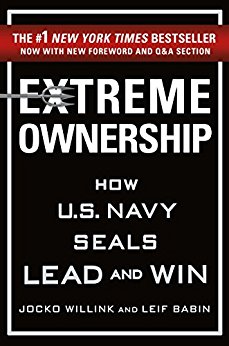

This article is an excerpt from the Shortform summary of "Extreme Ownership" by Jocko Willink and Leif Babin. Shortform has the world's best summaries of books you should be reading.
Like this article? Sign up for a free trial here .
What is the key to being a great leader? Is it about having the right personality type, training, or team? Former U.S. Navy SEALs Jocko Willink and Leif Babin, authors of Extreme Ownership, argue that the best leaders take responsibility for every aspect of their team and every task they’re working to accomplish.
Extreme Ownership is total accountability over everything that happens under a leader’s direction. Extreme ownership requires a leader to own her team’s mistakes and failures — without blame or excuses — and objectively assess what works and what doesn’t in order to constantly improve. As Willink and Babin warn, the concept is simple but not easy.
Willink and Babin honed the leadership principles of Extreme Ownership while serving in Ramadi, Iraq, the deadly and hostile center of enemy insurgency, during Operation Iraqi Freedom. After their military careers, they helped companies apply the same tenets in a corporate context through their business consulting firm, Echelon Front.
Extreme Ownership
This chapter focuses on how leaders can practice Extreme Ownership by taking accountability for everything that happens under their direction. Leadership carries great responsibility, and a leader’s authority to direct her team means that she is also the one who must answer for the team’s performance.
If an employee or subordinate makes a mistake, a leader should not blame him. Instead, the leader has to question whether she adequately explained the mission and the plan, and if she gave the team member the training and resources he would need to be successful.
If a member of your team is underperforming, you must take it upon yourself to train and mentor that person for the good of the team. However, if the team member continues to fall short, the leader eventually needs to make the call to fire that person and replace him with someone more competent. The success of the team as a whole (and its goals) is always more important than any one individual, whether the boss or an employee. This is true Extreme Ownership.
Extreme Ownership calls for leaders to take full responsibility for their failures. This is one of the hardest aspects of leadership: It’s tough enough admitting your mistakes as an individual, but it’s even harder when you’ve been charged with leading a whole team of people and have to own up to leading them astray or failing them in some way. Nonetheless, this is absolutely necessary to learn, grow, and succeed.
If you deny or try to shift the blame for a failure, you can’t learn or grow from it. Taking responsibility allows leaders to unflinchingly and objectively analyze a team’s problems and challenges; this process is critical to succeeding in the long run and continually improving.
This is even harder when you have to admit your — or your team’s — shortcomings to senior leadership. It may feel like professional suicide to call attention to your mistakes, but most likely your bosses are already aware of the lacking performance and will be impressed if you can own it and commit to improving it.
Don’t let your successes cloud your ability to see your failures (or areas that could use improvement). You may develop a great plan but come up short in leading your team to carry it out, or you perhaps you avoid one pitfall but fall victim to another. You can pat yourself on the back for your good work, but don’t neglect to take an objective view of everything and fix the issues that exist or find the ways you can be more effective next time. No person or plan is perfect, and there is always room for improvement. A good leader seeks constructive criticism and constantly looks for ways to perform better.
As a leader, don’t take credit for your team’s success. Instead, pass on the credit to all the team members and lower-level leaders who made success possible. This sets the tone for everyone on the team that success is achieved as a unit, creating a culture that is entirely focused on the good of the team.
When a leader takes responsibility for failures and gives credit to her team for successes, it serves as an example to the lower leaders to adopt the same mindset of Extreme Ownership. Infecting the whole team with an attitude of Extreme Ownership causes everyone to operate with the team and its mission as the main priority, and this puts the whole organization in the best position to succeed.
Battle Story: Taking Blame for a Battlefield Mistake
It’s the spring of 2006 and Willink is leading his forces in their first major operation in Ramadi, Iraq, where they’ll be deployed for nearly six months. Their mission involves about 300 U.S. and Iraqi troops, including SEALs, Army Soldiers, and Marines. The operation aims to wrest control of a particularly dangerous, enemy-held neighborhood called Mala’ab District from the enemy insurgent fighters.
The troops are progressing from building to building, clearing each one of enemy fighters as they go. A few hours into the mission, several gunfights are blazing between U.S. troops and insurgents.
A Marine sergeant reports to Willink that he is targeting a building where he suspects that enemies are hiding and have killed and wounded several Iraqi soldiers. A U.S. tank is positioned to shoot at the building, and the sergeant is coordinating airstrikes to also drop bombs on the building. However, Willink feels that something is off.
One of the SEAL sniper teams was originally stationed nearby, abandoned its post, and was in the midst of relocating when the gunfire went off at this building. The sniper team hasn’t yet reported their new location, and Willink worries that in the confusion of battle the SEALs could be in the targeted building.
Against the advice of the Marine sergeant, Willink insists on checking out the building before attacking. When he enters, rifle drawn, he comes face to face with a fellow SEAL.
The SEAL explains to Willink what happened: The SEAL sniper team had mistakenly shot the Iraqi soldiers, not recognizing them as friendly forces in the early morning darkness. Thinking they were under attack, the SEALs then called in for backup, and the Marines and Army troops responded by attacking this building, assuming it where the enemy fighters were located. The SEALs in the building couldn’t tell that it was U.S. troops shooting at them, so they fired back, and each side was convinced they were under vicious enemy attack.
Willink’s calm, clear thinking under (literal) fire prevented a bomb from dropping on the SEAL team. However, with one Iraqi soldier dead plus a SEAL and several Iraqi soldiers wounded, there had still been blue-on-blue (the term for friendly fire, or fratricide), which he explains is the absolute worst thing that can happen in battle. As a leader, he feels guilty and gravely responsible. He takes Extreme Ownership over the situation.

———End of Preview———
Like what you just read? Read the rest of the world's best summary of "Extreme Ownership" at Shortform . Learn the book's critical concepts in 20 minutes or less .
Here's what you'll find in our full Extreme Ownership summary :
- What Extreme Ownership means, and why every responsible leader needs to get it
- How to get your team working smoothly together
- How leadership principles from Navy SEAL teams work in everyday business and life






